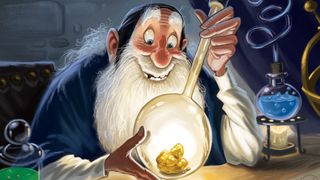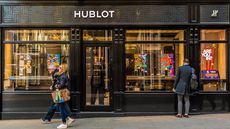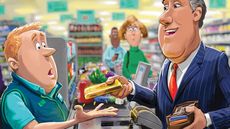How to climb the value chain to profits
A consumer product is generally the end result of a whole chain of activities. Some links in that chain make better investments than others. Richard Beddard explains.

A consumer product is generally the end result of a whole chain of activities. Some links in that chain make better investments than others. Richard Beddard explains.
When Daemonn Reeve became CEO of Treatt (LSE: TET) in 2012, he had a plan. The firm was an established trader of essential oils containing flavours and aromas extracted from orange and lemon peel. Treatt mainly used its expertise to buy low and sell high, profiting from changes in the price of the oils. However, profit yo-yoed as a result if orange oil had a good year, so did the company, but a bad year was also bad for Treatt and growth was haphazard. This dependence on essential oil prices was also demoralising for staff. There was little Treatt's traders and distillers could do to boost profit beyond using their trading knowledge to the company's advantage. So Reeve decided to use Treatt's expertise in sourcing and processing flavours to benefit its customers, calculating it would be a more profitable move in the long term. In short, he moved Treatt up the "value chain".
The value chain
The concept of the value chain was developed in the 1980s by the American academic Michael Porter. Porter has devoted his career to competitive strategy, and how getting it right enables some companies to deliver superior results to their rivals for long periods. Investors often focus on growth, or profit margins, to identify quality companies. But these alone won't sustain profitability if a company is wasteful with resources. Instead, Porter chose to focus on long-term returns on capital.
Subscribe to MoneyWeek
Subscribe to MoneyWeek today and get your first six magazine issues absolutely FREE

Sign up to Money Morning
Don't miss the latest investment and personal finances news, market analysis, plus money-saving tips with our free twice-daily newsletter
Don't miss the latest investment and personal finances news, market analysis, plus money-saving tips with our free twice-daily newsletter
The idea isn't new. In 1912, Donaldson Brown, a dynamite salesman working for chemicals giant DuPont, introduced a technique now known as DuPont analysis. This established the two drivers of return on capital: profit margin, and capital turnover (the ratio of sales to capital invested how much you need to invest to make a sale). When these two figures are multiplied together, you get the return (profit) on capital. The higher the profit margin on each sale, and the lower the capital needed to generate a sale, the higher the return on capital, and the more profitable a business is. In a free market, competition tends to whittle away excess returns. So if a company can maintain high, sustainable returns on capital, then it shows the company is not only satisfying its customers (because they keep buying), but it is also keeping its rivals at bay, because it can still charge enough, or keep its costs low enough, to maintain or even increase its profitability.
So how does a company generate a high return on capital? Porter realised it depends on two factors: "the value proposition", or what makes the company's products or services special, and "the value chain", or the sequence of activities required to produce them. A single firm is unlikely to perform all of the activities required to deliver a product or service to the end customer, so an individual company's value chain will be part of a longer, industry-wide value chain. Apple, for example, designs, sells and provides support for smartphones, but it also distributes them via mobile telephone networks. The parts are sourced from countless global suppliers the central processor is made by TSMC (the Taiwan Semiconductor Company), using designs licensed from ARM, a UK chip manufacturer. They are assembled into the iPhone chassis by companies like Foxconn in China. The raw materials are processed by others.
The key point in value chain analysis is that some of these activities are more profitable than others they add more value. Apple occupies a highly-profitable position in the chain of activity that delivers a smartphone into our hands. Even within Apple's own value chain, there will be activities that add more value, and others that add less. The focus of any company's strategy, Porter said, should be on those activities that are most profitable. And this is what Reeve's plan for Treatt recognised.
Juicing up profits
The value chain for orange oil starts with fruit juice processors. The peel, a waste product, contains the oil, which contains the essential flavours and aromas of the orange. Treatt buys and distills the orange oil, extracting the flavours and aromas into a concentrate. It sells the lighter molecules ("volatiles") to flavour houses, who combine them with other flavours, colours and preservatives in flavour systems for beverage companies. The heavier molecules which are more caustic and longer-lasting give household cleaner its clean, fresh, citrus smell. Reeve, who joined Treatt as a lab technician 20 years before he became CEO, believed the company had a good value proposition to build on. It had been distilling oil from suppliers around the world since the 1970s, adding value by supplying a consistent flavour, according to customers' specifications. It had also developed premium flavours trademarked Treattaromes made from a wide variety of whole fruits.
The company changed tack. Instead of aiming to maximise its profit from traded ingredients, it passed on lower prices to customers, in order to build more trusting, sustainable relationships with them, which opened the door to selling more profitable, higher-value-added products. It built on the expertise of its chemists and flavourists to develop new ingredients for the rapidly innovating beverage sector: craft beers, tea-flavoured drinks, and flavours that temper the sometimes-bitter aftertaste of sweeteners. Treatt targeted drinks companies directly as well as the flavour houses, and invited their flavourists to collaborate in its modest laboratory. Today, Treatt has an in-house wine steward; the marketing team hands out flavoured drinks at its Annual General Meetings; and forklift drivers take part in taste tests.
The biggest challenge, Reeve says, has been gearing up the entire staff to improve the customer experience. Treatt has achieved this through delegation, organising inter-departmental projects, and by giving shares to every employee. The next step is to finance a new £30m manufacturing facility and headquarters. Treatt's collection of six buildings on an old industrial estate on the edge of Bury St Edmunds no longer suits its collaborative ethos, or projects the technical image it wants to display to its customers. The investment is substantial nearly four times 2016 profits but the company is growing in confidence because its initiative has paid off. Treatt is growing across the board, but newer, value-added products are making the biggest contribution. In 2012, wholesaling raw ingredients accounted for 65% of Treatt's £74m in sales.
By 2016, this had shrunk to 50% of £88m in sales. Sales to multinational drinks companies have risen from 18% of the total to 25%. Profit margins have doubled, while Treatt's return on capital has grown from 8% or 9% a decade or so ago, to 15% in the last two years. And the share price has quadrupled.
| Five successful companies that are moving up the value chain | ||||
| Company | Ticker | Sector | Market capitalisation | Debt-adjusted p/e ratio |
| Animalcare | Aim: ANCR | Supplies generic and enhanced pet medicines, plus pet ID and veterinary products. | £65m | 22 |
| Solid State | Aim: SOLI | Makes and distributes specialist electronic parts, computer and communication systems, often used in harsh environments. | £41m | 9 |
| Treatt | LSE: TET | Sources and processes essential oils used in flavours, fragrances and cosmetics. Develops flavours. | £133m | 19 |
| Victrex | LSE: VCT | Manufactures PEEK, a tough and light polymer, and parts made from the material. | £1,620m | 19 |
| XP Power | LSE: XPP | Designs, makes and distributes power adapters for industrial and healthcare equipment. | £370m | 19 |
Finding value upstream
Treatt is developing its "downstream" activities (those that are closer to the end customer). But sometimes, going upstream can also take a company into more profitable waters. XP Power (LSE: XPP) distributes power adapters, which are built into medical and industrial equipment. It moved up the value chain a decade ago when it opened its first factory. XP had a network of sales offices around the world, and wanted to build on its close relationship with its customers. So it designed families of adapters that could be easily modified to fit its customers' specific requirements in XP's factories in China, and latterly Vietnam. Profitability soared.
Before 2010, XP's return on capital was typically below 20%. In recent years, it has not fallen below 30%. And while XP now designs and makes 68% of the power adapters it supplies by revenue, the company is still moving up the value chain. It is doing this by focusing on high-value, high-efficiency, environmentally friendly power adapters, and collaborating even more closely with its 30 biggest customers.
Sometimes a move up the value chain can be inspired not by the lure of higher profitability, but by an existing business coming under pressure. For example, 20 years ago, Solid State (Aim: SOLI), then a wholesaler of electronic components, was almost put out of business when the mass production of electronics largely migrated offshore mainly to China. With no one left to supply, Solid State had to move up the value chain or die. In 2002, it bought Steatite, a manufacturer, and went on to snap up several other small manufacturers and distributors, focusing on highly technical products and parts requiring specialist accreditations to handle. Today it continues to pick through surviving UK manufacturers and distributors, buying some of the smaller and more promising ones. It supplies antennae for Saab Gripen fighter planes, radios to UK special forces, rugged computers for air-traffic control systems, and the portable ticket machines used by conductors on UK trains. As a result, far from dying out, Solid State has achieved an average return on capital of 19% over the last decade.
Pet medicine and accessories distributor Animalcare (Aim: ANCR) is moving up the value chain by heading into research and development, and bypassing manufacturing, which it outsources.The company is investing in its own pipeline of generic drugs and "enhanced" generics (drugs that have been reformulated or repackaged to make them easier to administer, for example).
Eventually, Animalcare aims to produce entirely novel drugs. Last year, the company launched three generic drugs, the first from its own pipeline. Enhanced generics should start dripping from its pipeline in two or three years' time. If Animalcare can add more value with its own products, it should do very well. It has achieved an average return on capital of 45% over the past five years, since it disposed of Ritchey, a less profitable livestock business.
Expect a short-term squeeze
Sometimes the investment required for a company to move up the value chain squeezes profitability in the short-term. Victrex (LSE: VCT) has seen its return on capital fall steadily over the last five years (albeit to a still-impressive 22%) because it has invested in a new production facility even although it doesn't require much of the capacity as yet. Victrex makes PEEK. This polymer is so strong, light, and resistant to high temperatures and corrosion, it is replacing metals in a wide range of applications, from aircraft parts to medical implants. David Hummel, CEO since Victrex was spun out of ICI in 1993, likes to say the company's main competitor is metal.
Victrex makes about 4,000 tonnes of PEEK a year, and has the capacity to manufacture 7,000 tonnes. Total industry capacity will reach 11,000 tonnes once rival Solvay adds 1,000 tonnes later this year (there are two other major PEEK producers in the market). So why the big investment in capacity now? PEEK is a profitable market, but to expand it, Victrex must persuade engineers, dental laboratories and medical device manufacturers to switch from materials they are already very familiar with. So to hasten the adoption of PEEK, Victrex is moving up the value chain, producing PEEK in ever more shapes and grades, and producing part- or fully-finished components, sometimes with partners, to seed its markets with superior products.
Victrex now has six "mega programmes" underway. The first to prove themselves commercially have been Juvora (a dental disc that can be fashioned into dentures and implants) and Magma m-pipes (a new brand of subsea-oil pipeline). Both earned the company more than £1m in revenue in 2016. This is a small fraction of the £50m Victrex anticipates annually when each mega-programme peaks. To feed these programmes, which could take a decade or more to establish, Victrex must have the capacity, which explains its heavy investment now.
As Victrex shows, moving up the value chain means taking risks. Companies are incurring costs now to improve their competitive position, and therefore their returns, often many years from now. However, that is the very definition of investment. And these are exactly the sorts of companies long-term investors should be seeking out.
Richard Beddard founded an investment club before joining Interactive Investor as an editor at the height of the dotcom boom in 1999. in 2007 he started the Share Sleuth column for Money Observer magazine, which tracks a virtual portfolio of shares selected for the long-term by Richard. His career highlights include interviewing Nobel prize winners, private investors and many, many company executives.
Richard is freelance writer who invests in company shares and funds through his self-invested personal pension. He has worked as a teacher and in educational publishing, and is a governor at University Technology College, Cambridge. He supports the Livingstone Tanzania Trust, a charity supporting education and enterprise in Tanzania.
Richard studied International History and Politics at the University of Leeds, winning the Drummond-Wolff Prize for "distinguished work in the field of international relations".
-
 Coventry Building Society bids £780m for Co-operative Bank - what could it mean for customers?
Coventry Building Society bids £780m for Co-operative Bank - what could it mean for customers?Coventry Building Society has put in an offer of £780 million to buy Co-operative Bank. When will the potential deal happen and what could it mean for customers?
By Vaishali Varu Published
-
 Review: Three magnificent Beachcomber resorts in Mauritius
Review: Three magnificent Beachcomber resorts in MauritiusMoneyWeek Travel Ruth Emery explores the Indian Ocean island from Beachcomber resorts Shandrani, Trou aux Biches and Paradis
By Ruth Emery Published
-
 Invest in space: the final frontier for investors
Invest in space: the final frontier for investorsCover Story Matthew Partridge takes a look at how to invest in space, and explores the top stocks to buy to build exposure to this rapidly expanding sector.
By Dr Matthew Partridge Published
-
 Invest in Brazil as the country gets set for growth
Invest in Brazil as the country gets set for growthCover Story It’s time to invest in Brazil as the economic powerhouse looks set to profit from the two key trends of the next 20 years: the global energy transition and population growth, says James McKeigue.
By James McKeigue Published
-
 5 of the world’s best stocks
5 of the world’s best stocksCover Story Here are five of the world’s best stocks according to Rupert Hargreaves. He believes all of these businesses have unique advantages that will help them grow.
By Rupert Hargreaves Published
-
 The best British tech stocks from a thriving sector
The best British tech stocks from a thriving sectorCover Story Move over, Silicon Valley. Over the past two decades the UK has become one of the main global hubs for tech start-ups. Matthew Partridge explains why, and highlights the most promising investments.
By Dr Matthew Partridge Published
-
 Could gold be the basis for a new global currency?
Could gold be the basis for a new global currency?Cover Story Gold has always been the most reliable form of money. Now collaboration between China and Russia could lead to a new gold-backed means of exchange – giving prices a big boost, says Dominic Frisby
By Dominic Frisby Published
-
 How to invest in videogames – a Great British success story
How to invest in videogames – a Great British success storyCover Story The pandemic gave the videogame sector a big boost, and that strong growth will endure. Bruce Packard provides an overview of the global outlook and assesses the four key UK-listed gaming firms.
By Bruce Packard Published
-
 How to invest in smart factories as the “fourth industrial revolution” arrives
How to invest in smart factories as the “fourth industrial revolution” arrivesCover Story Exciting new technologies and trends are coming together to change the face of manufacturing. Matthew Partridge looks at the companies that will drive the fourth industrial revolution.
By Dr Matthew Partridge Published
-
 Why now is a good time to buy diamond miners
Why now is a good time to buy diamond minersCover Story Demand for the gems is set to outstrip supply, making it a good time to buy miners, says David J. Stevenson.
By David J Stevenson Last updated